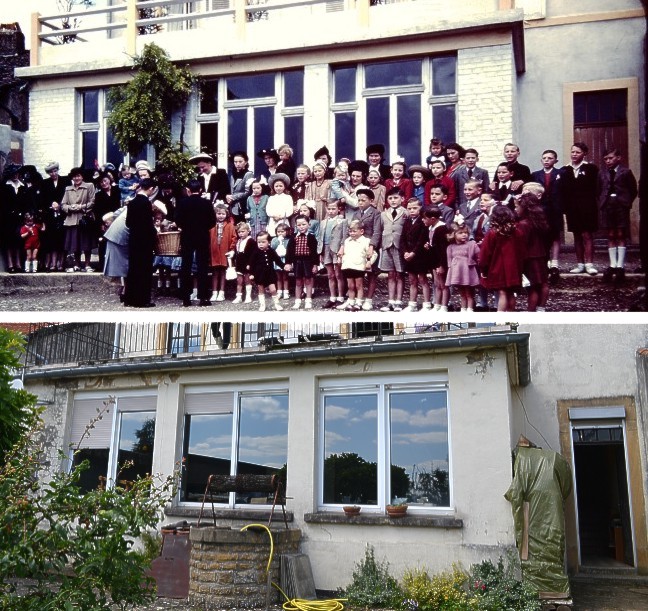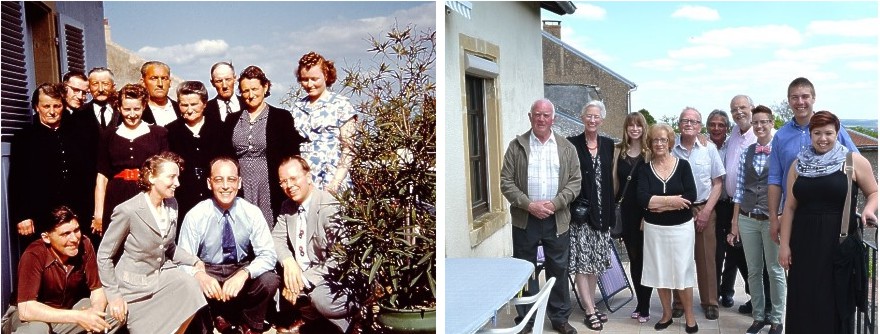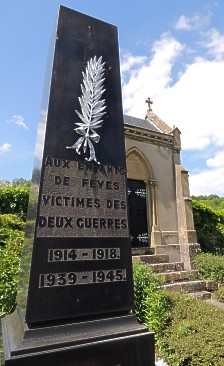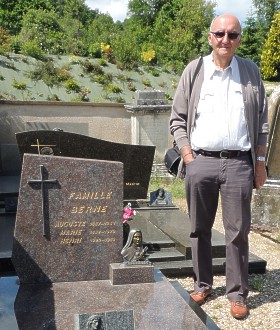When the group finished at the old rectory, it was a bit past noon. Vaughan was eager to visit the former school
building, but was informed they were already late for a reception at the village elementary school. There the
visitors would meet some of the village's officials and workers.
Mayor Girard explained that although there was a beautiful new cultural center on the southern edge of the village they
would have preferred to use, it was unavailable due to it being decorated for a wedding.
Top: The reception began with a champagne toast to the friendship of the two villages. It was an opportunity for the visitors and those who work for the village of Fèves to meet. Bottom: a light lunch featuring bread, cheese, meats and wine as well as the ever-present champagne.
After lunch, the visitors and their hosts strolled westward along Rue Haute until they reached number 32. Today, it is the home of
Jean-Pierre Bourquin and his wife Geneviève. But in 1949, it served as the school, mairie and the Henri Torlotting home.
The Bourquins had been hesitant to have visitors because they were in the middle of renovations.
The first stop was in the basement - the area that once was the classroom for the village school children.
The school classroom in 1949 (left) was in the basement. Today, (right) the same space is Jean-Pierre's workshop. While the photos were taken at slightly different locations and the contents of the room are very different, the lamp hanging from the ceiling in the right photo is at the same location as the right-most ceiling lamp in the older picture.
The group then moved outside into the backyard of the Bourquin home. The area had once served as both a playground for the school
children and the garden for the Henri Torlotting family.
As with the basement, changes had occurred during the 65 years since the Utleys’ visit, but the basic layout had remained the
same.
Top: Back of the Bourquin home in June of 1949 when it was the village school. The occasion was the visit by the Utleys. Billie Utley is bending over and reaching into the basket for some candy to give to the children. Bottom: a May 31, 2014 photo taken from approximately the same location. The windows and the balcony railing have been altered and guttering has been added to the balcony, but the basic layout is the same.
Jean-Pierre and Geneviève kindly offered refreshments and cookies on the same balcony where in 1949 a photo was taken during the Utley visit. Once again, changes had taken place, but similarities remained.
Left: June 1949 photo during the Utley visit to Fèves. Standing, (l-r): Marie (Mrs. Henri) Girard, priest Louis Holveck, mayor Auguste Berne, Mathilde (Mrs. Henri) Torlotting, Henri Girard, Marie (Mrs. Auguste) Berne, Emile Pierson, Marcelle (Mrs. Emile) Pierson, Billie Utley; kneeling: schoolmaster Henri Torlotting, Mrs. Yvonne Bazin, Yvonne's husband Leon "Jean" Bazin, and Ed Utley. Emile Pierson was the first deputy mayor. The Girards were close friends of the Torlottings. Right: May 31, 2014 (l-r): Mayor René Girard, Gloria Freeland, Katherine Vaughan, Genevieve and Jean-Pierre Bourquin, Gérard Torlotting, Art and Mariya Vaughan, Ryan and Hannah Serwe.
After saying "Merci!" and "Au revoir!" to the Bourquins, the visitors and their hosts walked westward on Rue Haute to the war
memorial on the north side of the street.
The people of Lorraine, much like the people of nearby Alsace, have to be a bit more careful than some in how they
recognize the sacrifices of their war dead. Both areas have passed many years as part of Germany so local families are
connected to both countries.
The consequence is that any mention of World War I, World War II or even the Franco-Prussian war of 1870 is stated
without identifying either as the aggressor.
"To the children of Fèves, victims of the two wars"
After leaving the memorial, the group continued in a westerly direction on Rue Haute until they reached
the cemetery at the edge of the village. Vaughan wished to see the grave of Mayor Auguste Berne, who, along with the
priest and schoolteacher, guided the sister-city relationship at the start. Berne died in November of 1951.
Marc Davoli next to the graves of his
grandparents Auguste and Marie Berne.
The next stop was intimately involved with a small yellowish plum called a mirabelle. It played a role in why
Morganville had hesitated in moving forward in its adoption of Fèves. The village is located in a part of France conducive
to growing the plum, which is native to the Middle East, and is usually eaten fresh, made into preserves or baked into pies. But
some use it in another way.







